C-section - series
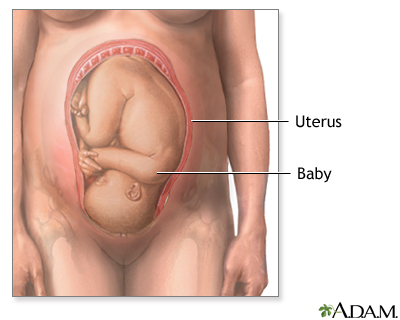
Normal anatomy
In a normal pregnancy, the baby is positioned head down in the uterus.
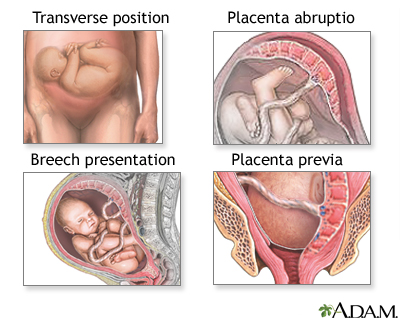
Indications
Sometimes the baby is in a position, like breech (buttocks-first) or transverse (cross-wise), that makes a vaginal birth risky. Other times certain medical conditions, such as placenta previa (placenta is attached too low, blocking the baby's exit) or placenta abruptio (placenta is partially or completely detached, threatening the baby's oxygen and nutrient supply), make vaginal birth nearly impossible.
A Cesarean section delivery is performed if a vaginal birth is not safe or possible for the mother or the baby.
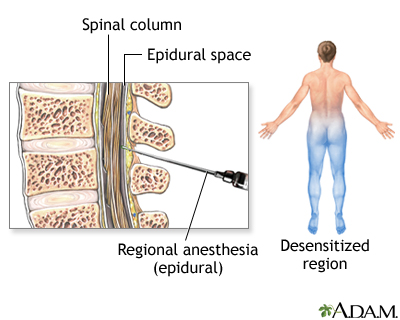
Procedure, part 1
Many doctors prefer using general anesthesia, which renders the patient unconscious, for emergency C-sections because it can be administered quickly and takes effect almost immediately. When the C-section is planned, the doctor may order regional anesthetics (a spinal or an epidural), which numbs only the lower portion of the body.
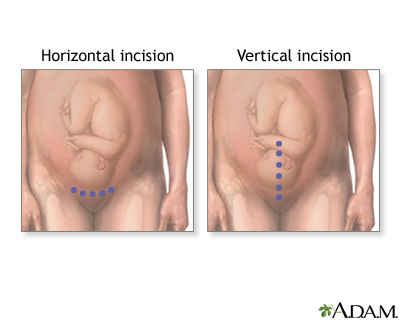
Procedure, part 2
After the anesthesia takes effect, the surgeon makes an abdominal incision. In non-emergency C-sections, the surgeon usually makes a horizontal incision (a bikini cut) across the abdomen, just above the pubic area. In an emergency situation, the surgeon occasionally needs to make a vertical cut, from below the navel to just above the pubic area. A vertical cut sometimes allows quicker access to the baby.
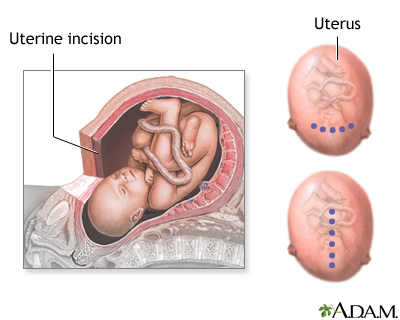
Procedure, part 3
Next, the surgeon opens the uterus with either a horizontal or vertical incision, regardless the direction of the skin/abdominal incision. A vertical incision on the uterus causes less bleeding and better access to the fetus, but renders the mother unable to attempt a vaginal delivery (must have another repeat C-section) in the future.
If you end up with a horizontal incision, you will have the option of either going through a trial of labor (TOL) or electing a repeat c-section.
The reason for the differences between the two is that patients with vertical uterine incisions have a much higher chance of rupturing the uterus (8% to 10%) in the future pregnancies, compared to only 1% in those with horizontal incisions.
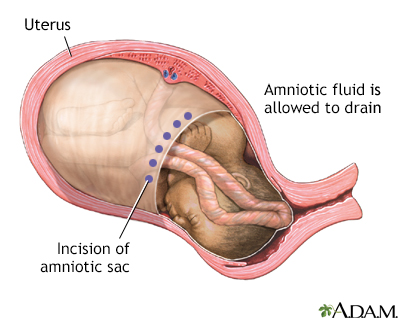
Procedure, part 4
Finally, the surgeon cuts through the amniotic sac enclosing the baby. He then allows the amniotic fluid to escape.
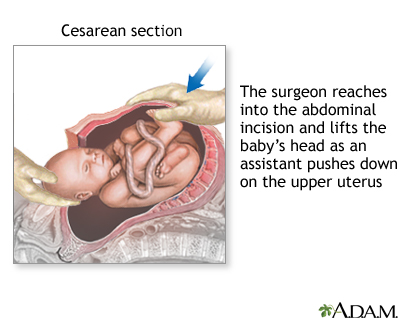
Procedure, part 5
The surgeon reaches into the uterus and lifts the baby's head. An assistant pushes down on the mother's upper uterus to help guide the baby out.
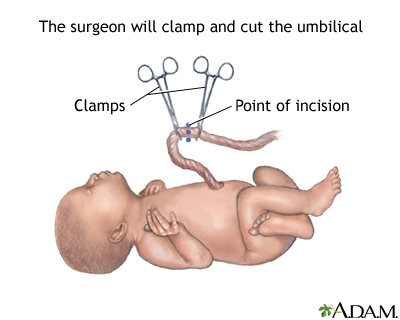
Procedure, part 6
The surgeon will clamp and cut the umbilical cord.
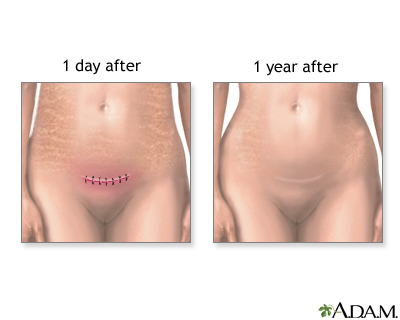
Aftercare
A typical hospital stay after C-section delivery is two to three days. Usually, the doctor encourages the mother to get up and move around soon after surgery to aid healing and to prevent complications. For the first few weeks, the abdominal incision will be sore. The scar will lighten as it heals.
Related Information
C-sectionYour baby in the birth canal
BACK TO TOP
Review Date: 10/15/2024
Reviewed By: John D. Jacobson, MD, Professor Emeritus, Department of Obstetrics and Gynecology, Loma Linda University School of Medicine, Loma Linda, CA. Also reviewed by David C. Dugdale, MD, Medical Director, Brenda Conaway, Editorial Director, and the A.D.A.M. Editorial team.

Health Content Provider
06/01/2025
|
A.D.A.M., Inc. is accredited by URAC, for Health Content Provider (www.urac.org). URAC's accreditation program is an independent audit to verify that A.D.A.M. follows rigorous standards of quality and accountability. A.D.A.M. is among the first to achieve this important distinction for online health information and services. Learn more about A.D.A.M.'s editorial policy, editorial process and privacy policy. A.D.A.M. is also a founding member of Hi-Ethics. This site complied with the HONcode standard for trustworthy health information from 1995 to 2022, after which HON (Health On the Net, a not-for-profit organization that promoted transparent and reliable health information online) was discontinued. |
The information provided herein should not be used during any medical emergency or for the diagnosis or treatment of any medical condition. A licensed medical professional should be consulted for diagnosis and treatment of any and all medical conditions. Links to other sites are provided for information only -- they do not constitute endorsements of those other sites. © 1997- 2025 A.D.A.M., a business unit of Ebix, Inc. Any duplication or distribution of the information contained herein is strictly prohibited.
